Leadership and Motivation: Improving Performance in Salisbury
VerifiedAdded on 2023/06/18
|6
|1296
|360
Report
AI Summary
This report examines how leadership can inspire and motivate staff members to improve performance, focusing on the Salisbury organisation. It highlights the transformational leadership approach and its components, such as intellectual stimulation, individualized consideration, inspirational motivation, and idealized influence. The report also discusses the behavioural theory of leadership, including autocratic, democratic, and laissez-faire styles, and their effects on employee performance. Ultimately, it concludes that transformational and democratic leadership styles, when effectively implemented, can enhance employee performance by fostering a sense of ownership, encouraging open communication, and aligning individual objectives with organizational goals. Desklib provides access to this and many other solved assignments for students.
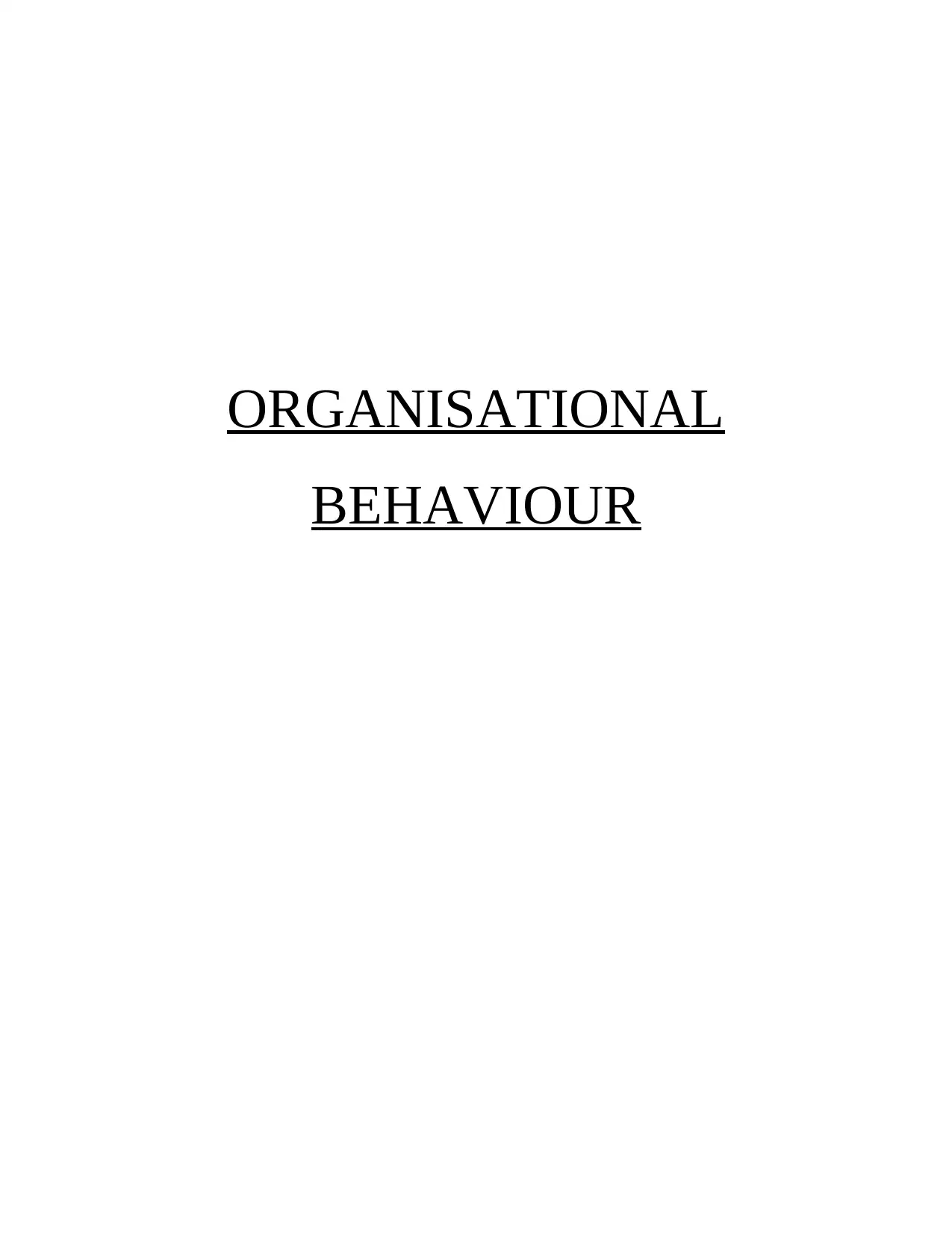
ORGANISATIONAL
BEHAVIOUR
BEHAVIOUR
Paraphrase This Document
Need a fresh take? Get an instant paraphrase of this document with our AI Paraphraser

TABLE OF CONTENTS
INTRODUCTION...........................................................................................................................3
How leadership can inspire and motivate staff members to improve performances...................3
CONCLUSION................................................................................................................................5
REFERENCES................................................................................................................................7
2
INTRODUCTION...........................................................................................................................3
How leadership can inspire and motivate staff members to improve performances...................3
CONCLUSION................................................................................................................................5
REFERENCES................................................................................................................................7
2
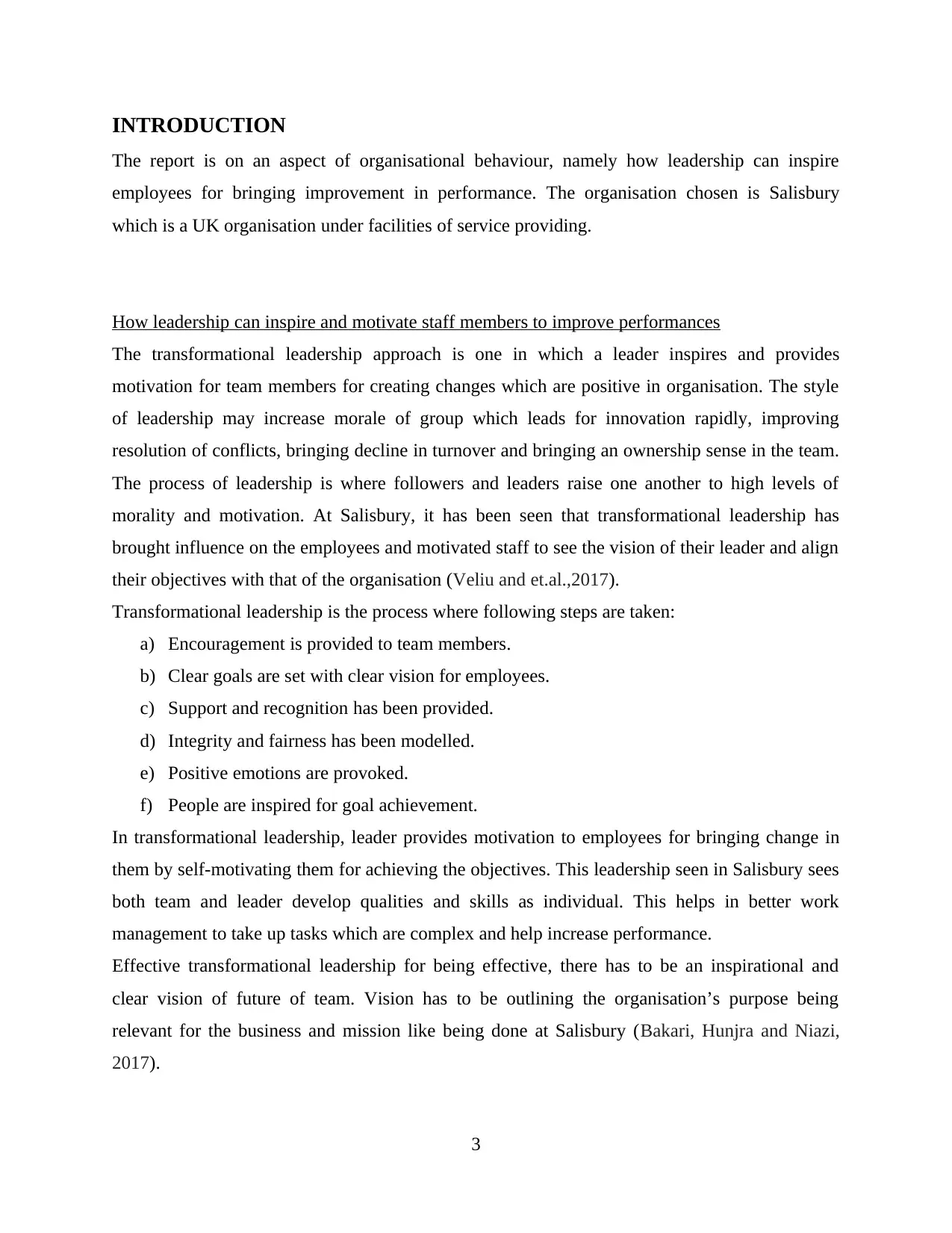
INTRODUCTION
The report is on an aspect of organisational behaviour, namely how leadership can inspire
employees for bringing improvement in performance. The organisation chosen is Salisbury
which is a UK organisation under facilities of service providing.
How leadership can inspire and motivate staff members to improve performances
The transformational leadership approach is one in which a leader inspires and provides
motivation for team members for creating changes which are positive in organisation. The style
of leadership may increase morale of group which leads for innovation rapidly, improving
resolution of conflicts, bringing decline in turnover and bringing an ownership sense in the team.
The process of leadership is where followers and leaders raise one another to high levels of
morality and motivation. At Salisbury, it has been seen that transformational leadership has
brought influence on the employees and motivated staff to see the vision of their leader and align
their objectives with that of the organisation (Veliu and et.al.,2017).
Transformational leadership is the process where following steps are taken:
a) Encouragement is provided to team members.
b) Clear goals are set with clear vision for employees.
c) Support and recognition has been provided.
d) Integrity and fairness has been modelled.
e) Positive emotions are provoked.
f) People are inspired for goal achievement.
In transformational leadership, leader provides motivation to employees for bringing change in
them by self-motivating them for achieving the objectives. This leadership seen in Salisbury sees
both team and leader develop qualities and skills as individual. This helps in better work
management to take up tasks which are complex and help increase performance.
Effective transformational leadership for being effective, there has to be an inspirational and
clear vision of future of team. Vision has to be outlining the organisation’s purpose being
relevant for the business and mission like being done at Salisbury (Bakari, Hunjra and Niazi,
2017).
3
The report is on an aspect of organisational behaviour, namely how leadership can inspire
employees for bringing improvement in performance. The organisation chosen is Salisbury
which is a UK organisation under facilities of service providing.
How leadership can inspire and motivate staff members to improve performances
The transformational leadership approach is one in which a leader inspires and provides
motivation for team members for creating changes which are positive in organisation. The style
of leadership may increase morale of group which leads for innovation rapidly, improving
resolution of conflicts, bringing decline in turnover and bringing an ownership sense in the team.
The process of leadership is where followers and leaders raise one another to high levels of
morality and motivation. At Salisbury, it has been seen that transformational leadership has
brought influence on the employees and motivated staff to see the vision of their leader and align
their objectives with that of the organisation (Veliu and et.al.,2017).
Transformational leadership is the process where following steps are taken:
a) Encouragement is provided to team members.
b) Clear goals are set with clear vision for employees.
c) Support and recognition has been provided.
d) Integrity and fairness has been modelled.
e) Positive emotions are provoked.
f) People are inspired for goal achievement.
In transformational leadership, leader provides motivation to employees for bringing change in
them by self-motivating them for achieving the objectives. This leadership seen in Salisbury sees
both team and leader develop qualities and skills as individual. This helps in better work
management to take up tasks which are complex and help increase performance.
Effective transformational leadership for being effective, there has to be an inspirational and
clear vision of future of team. Vision has to be outlining the organisation’s purpose being
relevant for the business and mission like being done at Salisbury (Bakari, Hunjra and Niazi,
2017).
3
⊘ This is a preview!⊘
Do you want full access?
Subscribe today to unlock all pages.

Trusted by 1+ million students worldwide
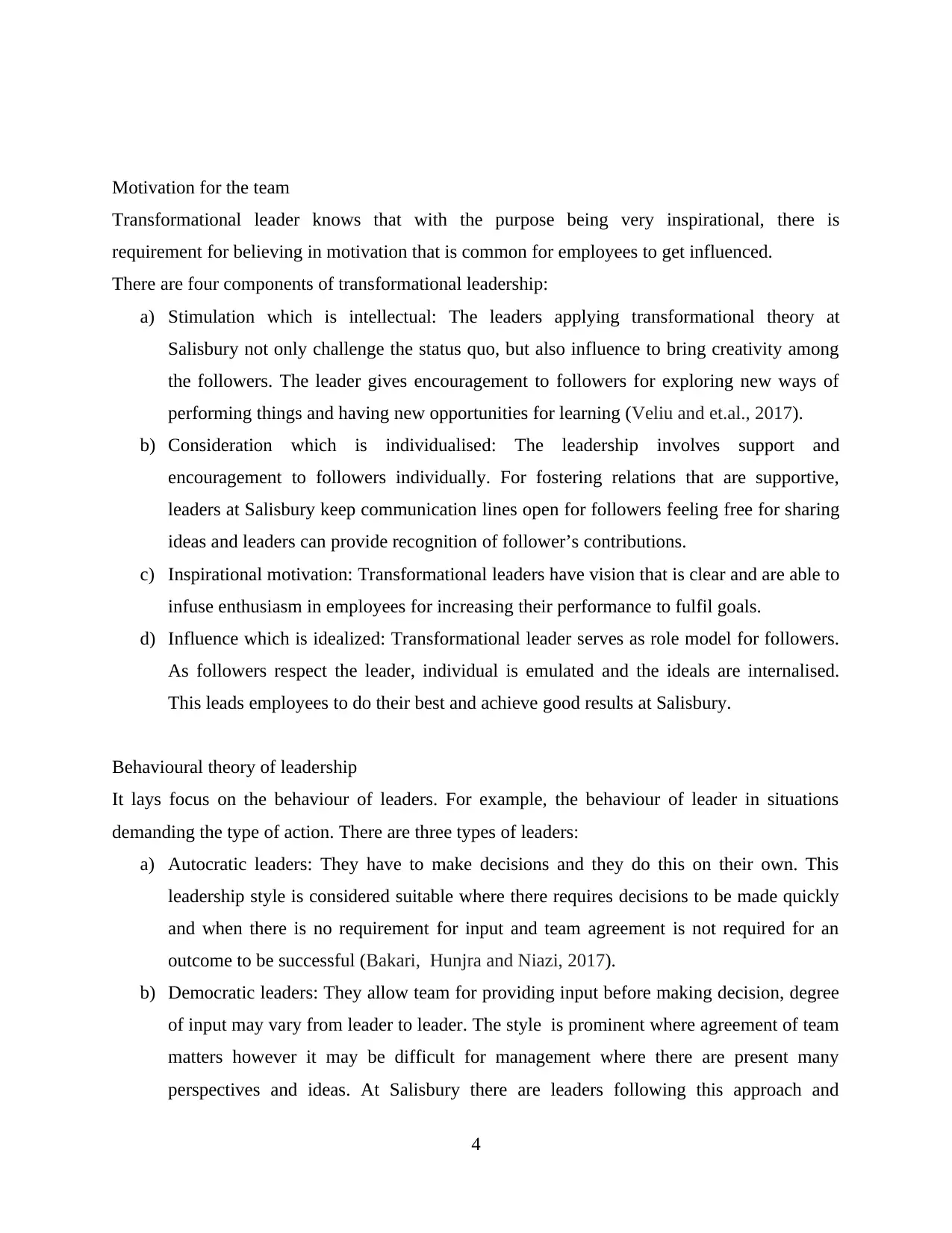
Motivation for the team
Transformational leader knows that with the purpose being very inspirational, there is
requirement for believing in motivation that is common for employees to get influenced.
There are four components of transformational leadership:
a) Stimulation which is intellectual: The leaders applying transformational theory at
Salisbury not only challenge the status quo, but also influence to bring creativity among
the followers. The leader gives encouragement to followers for exploring new ways of
performing things and having new opportunities for learning (Veliu and et.al., 2017).
b) Consideration which is individualised: The leadership involves support and
encouragement to followers individually. For fostering relations that are supportive,
leaders at Salisbury keep communication lines open for followers feeling free for sharing
ideas and leaders can provide recognition of follower’s contributions.
c) Inspirational motivation: Transformational leaders have vision that is clear and are able to
infuse enthusiasm in employees for increasing their performance to fulfil goals.
d) Influence which is idealized: Transformational leader serves as role model for followers.
As followers respect the leader, individual is emulated and the ideals are internalised.
This leads employees to do their best and achieve good results at Salisbury.
Behavioural theory of leadership
It lays focus on the behaviour of leaders. For example, the behaviour of leader in situations
demanding the type of action. There are three types of leaders:
a) Autocratic leaders: They have to make decisions and they do this on their own. This
leadership style is considered suitable where there requires decisions to be made quickly
and when there is no requirement for input and team agreement is not required for an
outcome to be successful (Bakari, Hunjra and Niazi, 2017).
b) Democratic leaders: They allow team for providing input before making decision, degree
of input may vary from leader to leader. The style is prominent where agreement of team
matters however it may be difficult for management where there are present many
perspectives and ideas. At Salisbury there are leaders following this approach and
4
Transformational leader knows that with the purpose being very inspirational, there is
requirement for believing in motivation that is common for employees to get influenced.
There are four components of transformational leadership:
a) Stimulation which is intellectual: The leaders applying transformational theory at
Salisbury not only challenge the status quo, but also influence to bring creativity among
the followers. The leader gives encouragement to followers for exploring new ways of
performing things and having new opportunities for learning (Veliu and et.al., 2017).
b) Consideration which is individualised: The leadership involves support and
encouragement to followers individually. For fostering relations that are supportive,
leaders at Salisbury keep communication lines open for followers feeling free for sharing
ideas and leaders can provide recognition of follower’s contributions.
c) Inspirational motivation: Transformational leaders have vision that is clear and are able to
infuse enthusiasm in employees for increasing their performance to fulfil goals.
d) Influence which is idealized: Transformational leader serves as role model for followers.
As followers respect the leader, individual is emulated and the ideals are internalised.
This leads employees to do their best and achieve good results at Salisbury.
Behavioural theory of leadership
It lays focus on the behaviour of leaders. For example, the behaviour of leader in situations
demanding the type of action. There are three types of leaders:
a) Autocratic leaders: They have to make decisions and they do this on their own. This
leadership style is considered suitable where there requires decisions to be made quickly
and when there is no requirement for input and team agreement is not required for an
outcome to be successful (Bakari, Hunjra and Niazi, 2017).
b) Democratic leaders: They allow team for providing input before making decision, degree
of input may vary from leader to leader. The style is prominent where agreement of team
matters however it may be difficult for management where there are present many
perspectives and ideas. At Salisbury there are leaders following this approach and
4
Paraphrase This Document
Need a fresh take? Get an instant paraphrase of this document with our AI Paraphraser
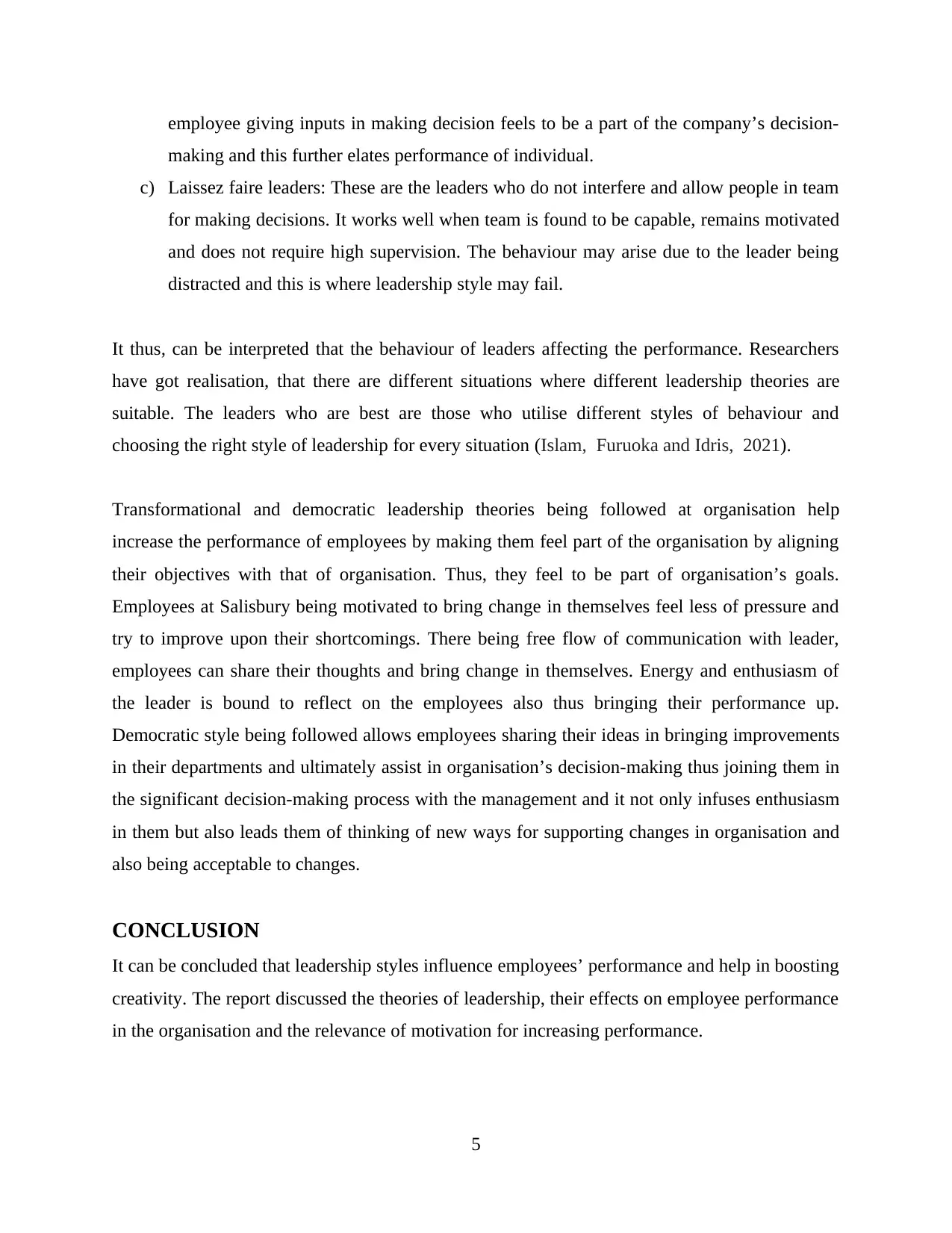
employee giving inputs in making decision feels to be a part of the company’s decision-
making and this further elates performance of individual.
c) Laissez faire leaders: These are the leaders who do not interfere and allow people in team
for making decisions. It works well when team is found to be capable, remains motivated
and does not require high supervision. The behaviour may arise due to the leader being
distracted and this is where leadership style may fail.
It thus, can be interpreted that the behaviour of leaders affecting the performance. Researchers
have got realisation, that there are different situations where different leadership theories are
suitable. The leaders who are best are those who utilise different styles of behaviour and
choosing the right style of leadership for every situation (Islam, Furuoka and Idris, 2021).
Transformational and democratic leadership theories being followed at organisation help
increase the performance of employees by making them feel part of the organisation by aligning
their objectives with that of organisation. Thus, they feel to be part of organisation’s goals.
Employees at Salisbury being motivated to bring change in themselves feel less of pressure and
try to improve upon their shortcomings. There being free flow of communication with leader,
employees can share their thoughts and bring change in themselves. Energy and enthusiasm of
the leader is bound to reflect on the employees also thus bringing their performance up.
Democratic style being followed allows employees sharing their ideas in bringing improvements
in their departments and ultimately assist in organisation’s decision-making thus joining them in
the significant decision-making process with the management and it not only infuses enthusiasm
in them but also leads them of thinking of new ways for supporting changes in organisation and
also being acceptable to changes.
CONCLUSION
It can be concluded that leadership styles influence employees’ performance and help in boosting
creativity. The report discussed the theories of leadership, their effects on employee performance
in the organisation and the relevance of motivation for increasing performance.
5
making and this further elates performance of individual.
c) Laissez faire leaders: These are the leaders who do not interfere and allow people in team
for making decisions. It works well when team is found to be capable, remains motivated
and does not require high supervision. The behaviour may arise due to the leader being
distracted and this is where leadership style may fail.
It thus, can be interpreted that the behaviour of leaders affecting the performance. Researchers
have got realisation, that there are different situations where different leadership theories are
suitable. The leaders who are best are those who utilise different styles of behaviour and
choosing the right style of leadership for every situation (Islam, Furuoka and Idris, 2021).
Transformational and democratic leadership theories being followed at organisation help
increase the performance of employees by making them feel part of the organisation by aligning
their objectives with that of organisation. Thus, they feel to be part of organisation’s goals.
Employees at Salisbury being motivated to bring change in themselves feel less of pressure and
try to improve upon their shortcomings. There being free flow of communication with leader,
employees can share their thoughts and bring change in themselves. Energy and enthusiasm of
the leader is bound to reflect on the employees also thus bringing their performance up.
Democratic style being followed allows employees sharing their ideas in bringing improvements
in their departments and ultimately assist in organisation’s decision-making thus joining them in
the significant decision-making process with the management and it not only infuses enthusiasm
in them but also leads them of thinking of new ways for supporting changes in organisation and
also being acceptable to changes.
CONCLUSION
It can be concluded that leadership styles influence employees’ performance and help in boosting
creativity. The report discussed the theories of leadership, their effects on employee performance
in the organisation and the relevance of motivation for increasing performance.
5
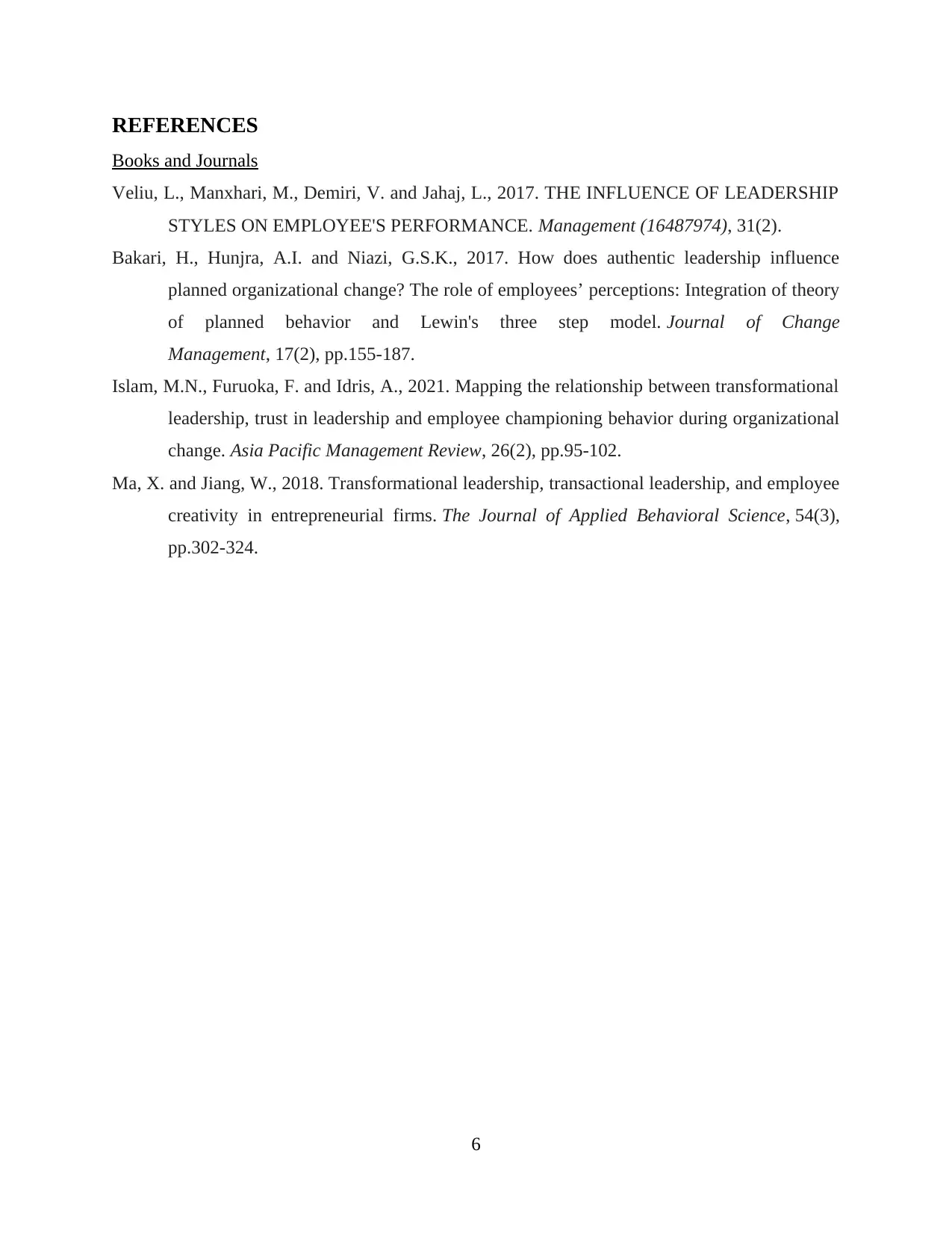
REFERENCES
Books and Journals
Veliu, L., Manxhari, M., Demiri, V. and Jahaj, L., 2017. THE INFLUENCE OF LEADERSHIP
STYLES ON EMPLOYEE'S PERFORMANCE. Management (16487974), 31(2).
Bakari, H., Hunjra, A.I. and Niazi, G.S.K., 2017. How does authentic leadership influence
planned organizational change? The role of employees’ perceptions: Integration of theory
of planned behavior and Lewin's three step model. Journal of Change
Management, 17(2), pp.155-187.
Islam, M.N., Furuoka, F. and Idris, A., 2021. Mapping the relationship between transformational
leadership, trust in leadership and employee championing behavior during organizational
change. Asia Pacific Management Review, 26(2), pp.95-102.
Ma, X. and Jiang, W., 2018. Transformational leadership, transactional leadership, and employee
creativity in entrepreneurial firms. The Journal of Applied Behavioral Science, 54(3),
pp.302-324.
6
Books and Journals
Veliu, L., Manxhari, M., Demiri, V. and Jahaj, L., 2017. THE INFLUENCE OF LEADERSHIP
STYLES ON EMPLOYEE'S PERFORMANCE. Management (16487974), 31(2).
Bakari, H., Hunjra, A.I. and Niazi, G.S.K., 2017. How does authentic leadership influence
planned organizational change? The role of employees’ perceptions: Integration of theory
of planned behavior and Lewin's three step model. Journal of Change
Management, 17(2), pp.155-187.
Islam, M.N., Furuoka, F. and Idris, A., 2021. Mapping the relationship between transformational
leadership, trust in leadership and employee championing behavior during organizational
change. Asia Pacific Management Review, 26(2), pp.95-102.
Ma, X. and Jiang, W., 2018. Transformational leadership, transactional leadership, and employee
creativity in entrepreneurial firms. The Journal of Applied Behavioral Science, 54(3),
pp.302-324.
6
⊘ This is a preview!⊘
Do you want full access?
Subscribe today to unlock all pages.

Trusted by 1+ million students worldwide
1 out of 6
Related Documents
Your All-in-One AI-Powered Toolkit for Academic Success.
+13062052269
info@desklib.com
Available 24*7 on WhatsApp / Email
![[object Object]](/_next/static/media/star-bottom.7253800d.svg)
Unlock your academic potential
Copyright © 2020–2025 A2Z Services. All Rights Reserved. Developed and managed by ZUCOL.




